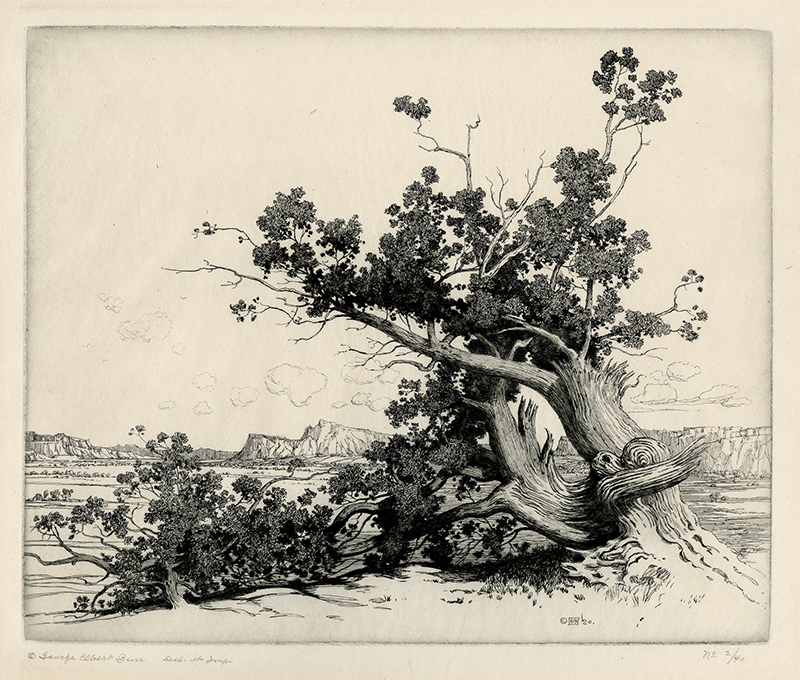Old Cedars New Mexico is an etching from 1920 by American artist, George Elbert Burr (1859-1939). It is pencil signed and inscribed Del. et Imp., and editioned No 2/40 in the lower margin. The artist's monogram and the date are incised into the plate in the lower right image. Old Cedars New Mexico was printed by the artist on ivory J Whatman 1915 watermarked wove paper and the platemark measures 9-3/4 x 11-3/4 inches. The references are Seeber 218, American Etchers 218, and Library of Congress 59.
Old Cedars New Mexico captures the rugged beauty of the high desert of New Mexico. The scene overlooks an arid valley that is hemmed in by high mesas. Burr’s title is misleading as according to Tony Genntro, a desert biologist, there are no native cedars in New Mexico. These are junipers and are frequently and falsely referred to as cedars. The United States Forest Service estimates that one quarter of New Mexico is covered with one-seed juniper.
George Elbert Burr, painter, printmaker, and illustrator, was born in Munroe Falls, Ohio on 14 April 1859 to Linus E. and Lucy Ellen Gaylord Burr, and was raised in Cameron, Missouri. His earliest instruction in drawing and painting was provided by his mother and he made his first attempts at etching in the early 1870s. In December 1878, Burr enrolled in the Chicago Academy of Design (now the School of the Art Institute of Chicago) but he terminated his studies in April of the following year. In 1888 he was creating illustrations for Schribner’s and Harper’s magazines as well as for John Muir’s Picturesque California, and, after moving to New York, he illustrated for Cosmopolitan and Leslie’s.
In 1906, Burr and his wife moved to Denver. A few of his color etchings were included in the 1915 Panama Pacific International Exposition and the following year he was represented by two etchings in the First Annual Exhibition of the Brooklyn Society of Etchers at the Brooklyn Museum. In 1921 he copyrighted the last of the thirty-five etchings in the Desert Set, which was circulated in exhibitions by the American Federation of Arts. For health reasons, Burr had to leave the winter chill of Denver and purchased a home in Phoenix, Arizona in 1927.
Burr was in the unique position of self-promoting his work and in January 1930 wrote to R. P. Tolman, assistant curator at the Smithsonian Institution: "It's lots of fun to be a 'poor artist.' Nearly fifty years I've been, except for health limitations, supremely happy in my work, and am constantly surprised in the number of people that also seem to get pleasure out of my labor. It seems so odd, that without effort, I've always sold more than Mrs. Burr and I have needed for all our fourteen years of travel and other so-called luxuries."
Burr was a member of the American Institute of Graphic Arts; Arizona Society of Artists; Brooklyn Society of Etchers; Cactus Club, Denver; California Society of Etchers; Denver Art Association; National Arts Club of New York; New York Society of Etchers; Phoenix Fine Art Association; Print Makers’ Society of California; and Société aux Etats-Unis. He served as the first president of the Denver Art Association and president of the Phoenix Art Association. During his lifetime Burr's work was exhibited at the Bibliothèque Nationale, Paris; the British Museum, and the Victoria & Albert Museum, London; the National Museum and the Smithsonian Institution, Washington D.C.; and the Brooklyn Museum.
George Elbert Burr died in Phoenix, Arizona on 17 November 1939.



